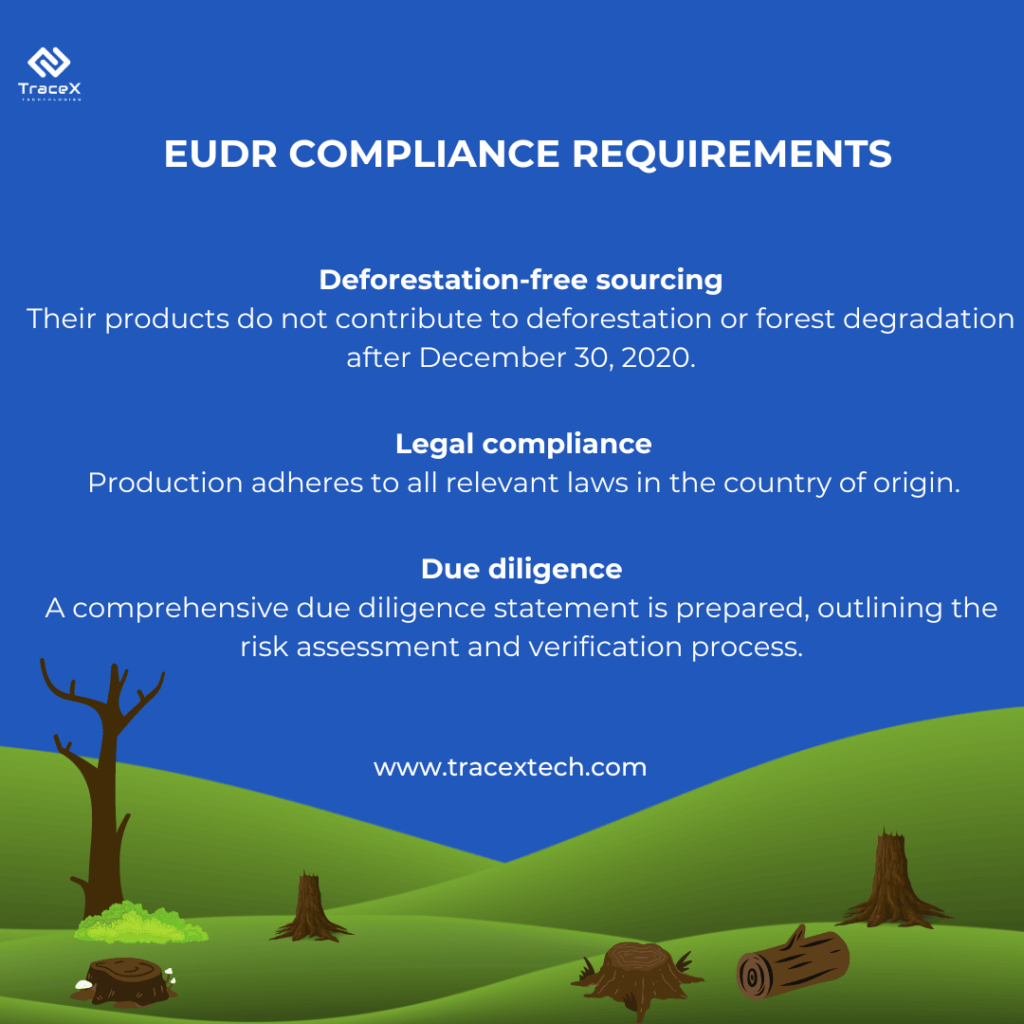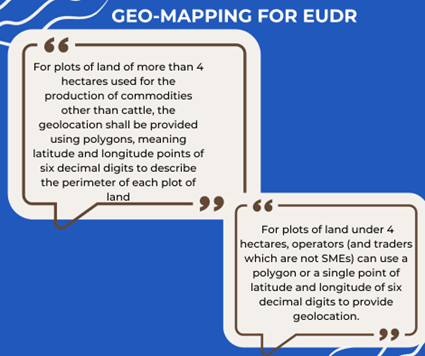Contact: +91 99725 24322 |
Menu
Menu
Quick summary: Unlock the secrets to navigating the EU Deforestation Regulation (EUDR) effortlessly. Delve into our insightful blog to understand the complexities of EUDR compliance, explore effective strategies, and discover innovative solutions. Stay ahead in the sustainability game and ensure your business aligns seamlessly with the evolving regulations. Read now to ease your journey towards a deforestation-free future.

In today’s world of global trade and environmental responsibility, few regulations have sparked as much conversation as the European Union’s Deforestation Regulation (EUDR).As sustainability heads and compliance officers scramble to align their operations with these stringent new rules, a pressing question arises: How can businesses not only achieve EUDR compliance but also turn this challenge into an opportunity for long-term sustainability and brand integrity?
The EUDR presents a daunting task—especially for companies entrenched in global supply chains, where transparency and traceability are often elusive. The potential risks of non-compliance, including hefty fines, reputational damage, and restricted market access, weigh heavily on the minds of those responsible for steering their organizations through these regulatory waters. Yet, amid these challenges lies a chance to demonstrate leadership in sustainability, setting a precedent for ethical business practices.
According to WWF, EU is the second biggest importer of deforestation after China. In 2017, the EU was responsible for 16% of deforestation associated with international trade, totalling 203,000 hectares and 116 million tonnes of CO₂.
Key Takeaways
The EU Deforestation-Free Regulation (EUDR) marks a fresh EU endeavour aimed at curbing global deforestation resulting from forestry and agricultural practices.
Being a major importer of commodities associated with deforestation, and recognizing its influential role, the deforestation regulation seeks to diminish the impact that products purchased by EU citizens have on global forests and woodlands. This initiative is integral to the journey toward achieving net-zero, and the EU aspires to set an example, potentially paving the way for similar regulatory requirements in other markets, including the UK.
The importance of EUDR compliance for businesses in global supply chains cannot be overstated, as it represents a significant shift towards sustainable and responsible sourcing practices. The European Union Deforestation Regulation (EUDR) aims to eliminate products linked to deforestation from the EU market, compelling companies to ensure that their commodities, such as palm oil, cocoa, and rubber, are sourced from deforestation-free areas. Compliance with the EUDR not only helps businesses avoid legal repercussions and potential penalties but also enhances their reputation in an increasingly eco-conscious marketplace.
By adhering to the EUDR, companies demonstrate their commitment to sustainability, which is becoming a critical factor for consumers and investors alike. The regulation requires businesses to implement rigorous due diligence processes, including detailed risk assessments and supply chain transparency, thereby fostering integrity and accountability. This proactive approach not only mitigates environmental risks but also opens up new market opportunities, as consumers increasingly prioritize products that align with their values regarding environmental conservation. In summary, EUDR compliance is essential for businesses to maintain market access, build stakeholder trust, and contribute to global efforts to combat deforestation and promote sustainable practices.
The European Union Deforestation Regulation (EUDR) has undergone significant timeline adjustments recently, reflecting the EU’s commitment to addressing deforestation while allowing stakeholders adequate preparation time.
Revised Application Dates
This delay was officially proposed by the European Commission on October 2, 2024, and subsequently approved by the European Parliament on November 14, 2024. The additional time is intended to ensure that all necessary implementation tools are ready and that stakeholders can adequately prepare for compliance with the new rules concerning products linked to deforestation.
Under the EUDR, certain commodities—including cattle, cocoa, coffee, oil palm, rubber, soya, and wood—must be sourced from land that has not been deforested or degraded since December 31, 2020. Importers and traders will need to provide extensive documentation to demonstrate compliance with these standards.
The regulation also introduces a country benchmarking system that categorizes nations based on their risk of contributing to deforestation. By June 30, 2025, the European Commission is expected to finalize this risk assessment framework.
These developments underscore the EU’s proactive approach to combating deforestation while balancing economic interests and environmental sustainability.
The European Union Deforestation Regulation (EUDR) establishes stringent compliance requirements that businesses must adhere to in order to ensure that their products are sourced from deforestation-free areas. This regulation is particularly relevant for commodities such as coffee, cocoa, palm oil, rubber, and timber. Here’s an in-depth look at the key compliance requirements outlined in the EUDR:

Due diligence is a critical process that requires operators and traders to assess and verify the sustainability of their supply chains. A Due Diligence Statement (DDS) is a formal declaration that confirms compliance with EUDR requirements, asserting that the relevant products are deforestation-free and produced in accordance with the laws of the country of origin. The importance of the DDS lies in its role as a safeguard against illegal deforestation and environmental degradation, ensuring that businesses take responsibility for their sourcing practices.
The DDS must include several key components to demonstrate compliance:
Conducting a deforestation risk assessment involves several steps:
Once risks are identified, businesses must implement strategies to mitigate them. This may include:
To demonstrate compliance with the EUDR, businesses must provide evidence that their products are sourced from deforestation-free areas. This includes:
Traceability and transparency are paramount in ensuring compliance with the EUDR. By establishing a clear line of sight from the end product back to its source, businesses can verify that their commodities are not linked to deforestation. This transparency not only helps in meeting regulatory requirements but also builds trust with consumers and stakeholders who increasingly demand sustainable and ethically sourced products.

The actions to be taken following the benchmarking system are contingent on the risk level attributed to the sourcing country and the outcomes of the preceding steps.
Step 1, securing trusted data, is obligatory and serves as the fundamental basis for subsequent steps. However, it also presents the most formidable challenge.
Countries are categorized into three risk levels: low, standard, and high. If a country is classified as low risk, there is no need to undertake the risk assessment, which constitutes step 2.
Completion of step 2, the risk assessment, without identifying evident risks obviates the necessity for step 3, risk mitigation, as there are no risks to address.
Upon the regulation’s enforcement, all risk levels will be standardized, gradually assigning risk levels to each country over time.
Start by developing internal policies tailored to EUDR regulation requirements. This involves drafting clear guidelines that align with the regulation’s demands, such as geolocation data collection and risk assessments. Appoint a dedicated compliance officer to oversee these initiatives. Training your staff is equally important—ensure they understand the nuances of EUDR and can execute compliance tasks proficiently.
Leverage technology to simplify and strengthen your compliance efforts. AI-powered tools and satellite monitoring systems are invaluable for tracking deforestation risks in real-time. Supply chain transparency solutions and Traceability platforms, like blockchain, offer an added layer of security, ensuring that all data is immutable and transparent. Automating data collection and reporting processes not only improves accuracy but also reduces the workload, allowing your team to focus on more strategic tasks.
Compliance is not just about internal processes; it’s also about working closely with your suppliers. Collaborate with them to ensure they understand and meet your deforestation-free policies. This might involve regular audits, shared training sessions, or even providing them with access to your compliance tools. Open communication is key—make sure they know what’s expected and how they can contribute to maintaining a compliant supply chain.
By focusing on these strategies, you’re not just checking a box—you’re creating a robust, sustainable supply chain that meets EUDR requirements and positions your company as a leader in environmental responsibility.
Penalties for non-compliance will be established in accordance with national law. Eventually, the objective is for violations of the EUDR to result in criminal penalties. However, within the EUDR framework itself, penalties may include:
As a Sustainability Head, Compliance Officer, or Procurement Head, you’re likely aware of the hurdles involved in EUDR compliance. Let’s delve into the common challenges and how you can overcome them:
Technology becomes your most reliable ally. Imagine having a digital assistant that never sleeps, tirelessly gathering and analyzing data from your supply chain. That’s what today’s advanced tools can offer. With EUDR compliance software, you can monitor deforestation risks in real-time, ensuring that your supply chain remains deforestation-free. Blockchain technology, in particular, adds a layer of transparency and trust, creating immutable records that simplify compliance reporting. These tools don’t just make compliance easier—they empower you to take proactive steps, mitigating risks before they become issues. Embracing these technologies not only aligns with regulatory demands but also strengthens your organization’s commitment to sustainability.
The thought of an EUDR audit might feel daunting, but with the right preparation, it can be an opportunity to showcase your organization’s commitment to responsible sourcing. Start by ensuring that all your documentation is in order—this includes geolocation data, supplier information, and evidence of deforestation-free practices. Conduct regular internal audits to identify any gaps in your compliance strategy. Remember, transparency is key. During the audit, be open and collaborative with the auditors, providing them with clear and accurate information. Consider this process as a partnership; their feedback can help you further strengthen your compliance framework. By preparing thoroughly, you turn the audit from a challenge into a chance to demonstrate your leadership in sustainability.
A comprehensive EUDR compliance checklist is essential for ensuring your business meets all regulatory requirements. It typically includes steps like preparing a Due Diligence Statement, conducting thorough risk assessments, and implementing traceability measures to verify deforestation-free supply chains.
Effective reporting is at the heart of EUDR compliance. It’s not just about ticking boxes; it’s about telling the story of your supply chain—how each link contributes to a deforestation-free future. Your reports should be comprehensive, detailing everything from your risk assessments to the actions you’ve taken to mitigate those risks. But more than that, they should be clear and accessible, making it easy for stakeholders to understand your compliance journey. Use technology to automate data collection and reporting, reducing the risk of errors and ensuring that your reports are always up-to-date. By focusing on transparent and detailed reporting, you build trust with regulators, partners, and consumers, reinforcing your brand’s reputation as a leader in sustainable business practices.
The TraceX EUDR Compliance Platform is designed to help businesses align with the European Union’s Deforestation Regulation (EUDR) by ensuring transparency, traceability, and compliance across the supply chain.
Explore our EUDR Compliance Platform
Navigating the complexities of EUDR compliance doesn’t have to be overwhelming. With the right tools, strategies, and support, your business can not only meet regulatory demands but also lead the way in sustainable practices. The TraceX EUDR Compliance Platform offers an integrated solution that streamlines risk monitoring, reporting, and traceability, ensuring your supply chain stays deforestation-free. By embracing these technologies, you can confidently steer your organization towards a compliant and sustainable future.
The EUDR requires the acquisition of geographic coordinates for the land where commodities are produced, a critical step in verifying deforestation absence. Employ various methods, such as mobile apps and GIS, to ensure compliance. Non-compliance with coordinate provision is a violation of the Regulation.
Combining commodities with a deforestation-free origin and those with an unknown origin is strictly prohibited. Full identity preservation and chain of custody is a mandatory requirement.
The Regulation requires that operators (or traders which are not SMEs) trace every relevant commodity back to its plot of land before making it available or placing it on the market, or before exporting it
